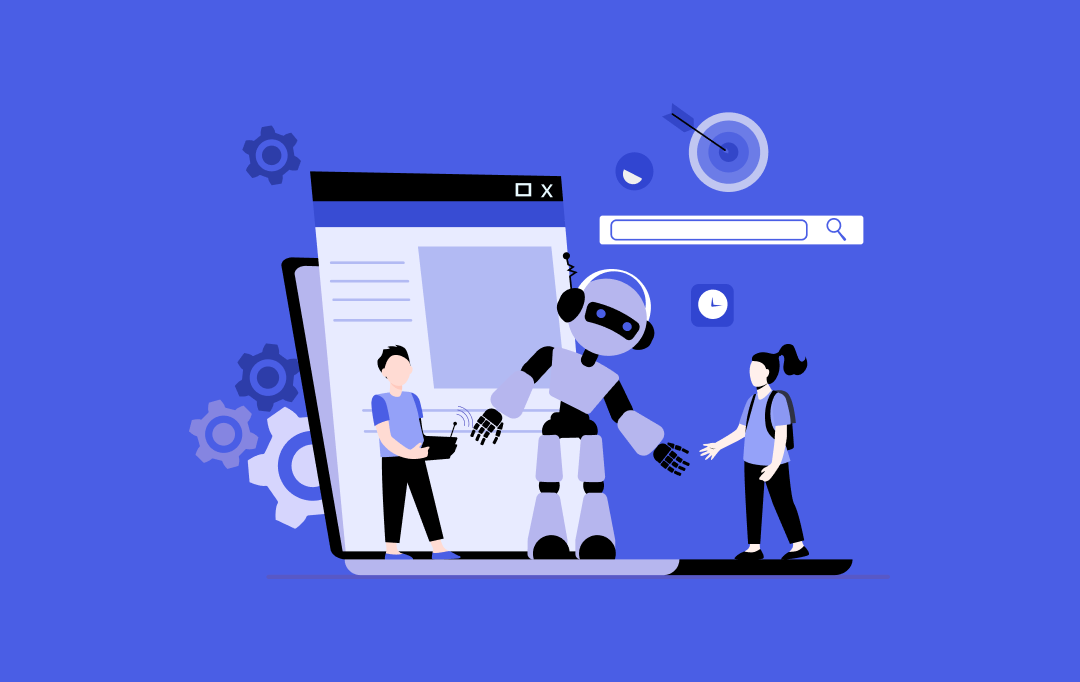- How to detect AI content
- Perplexity
- Burstiness
- Non-human linguistics
- Unusual syntactic and semantic patterns
- Cost of developing an AI content detection tool and factors associated with it
- Development Lifecycle of an AI Content Detection Tool
- Market research and planning
- Gathering and training dataset
- Transfer learning
- Build a beautiful front end
- Deployment and post-launch maintenance
- Why Appinventiv?
- FAQs
Ever since OpenAI released its now-a-game-changer AI chatbot, the business world has been tumultuous, to say the least. Every other industry is grappling to either embrace AI or curb the use of AI tools such as ChatGPT. For example, many educators are now asking how they can trust the assessments turned in by the students in this age of generative AI. On the other hand, the marketing industry is facing the looming threat of mass-produced low-quality AI-generated content.
Zeroing in on this threat, New York City’s education department banned ChatGPT for students and educators. However, AI content detection tool development is the strategy the industry is adopting to address the AI-field reality.
Also read: How to Successfully Navigate the legal nuances of Generative AI
To quote from a research paper by Oxford’s ‘Centre for Governance of AI’ researchers Markus Anderljung and Julian Hazell, “With improved detection capabilities, platforms could mitigate harm by labeling AI-generated content as such or remove media that violates their terms of service.” One method the paper discusses is not to make the model open-access. This will allow the developers of the AI model to effectively train the model to detect the content generated by it.
With the threat being particularly real for marketers, businesses such as Turnitin and Barnes & Noble Education are responding with their AI content detection tools to bridge the gap. And because the market is ripe, the competition is more relaxed in AI content detection development. Entrepreneurs are finding a lucrative opportunity to generate a second (or primary) revenue stream by building an AI content detection tool.
In this article, we will delve into the realm of generative AI consulting, focusing on the development cost of AI content detection tools (ranging between $50,000 and $200,000), its features, and benefits. considering the advancements made in generative AI services. Therefore in the name of John McCarthy (Considered the father of artificial intelligence), let’s discuss AI content detection tools in detail.
How to detect AI content
First thing first, a piece of AI-generated content that an individual has modified will be virtually undetectable. In addition to this, no tool is 100% accurate in detecting AI content. However, at the end of the day, an AI NLP (Natural Language Processing) chatbot is an elaborate algorithm trained to give natural language output. Therefore, if we know the algorithm on which the model functions, it can become easier to tell with a fair amount of certainty if a piece of content is AI-generated. Following are the parameters that can be used to detect AI content.

Perplexity
In relation to NLP modeling, perplexity refers to the probability of a word appearing in a sequence of words. In other words, it measures how well the language modal can predict the next word in a sequence of words. For example, if we test a chatbot’s perplexity for the next word in the sequence, “the cat sat on the…”, the perplexity will be higher for the moon (since it is less likely) and will be lower for the floor or mat (since they are more likely).
This gives us a fair idea of a modal’s confidence in predicting the next word. The thumb rule is that if the perplexity score of a fine-tuned language model is lower than that of a human-trained language model for a piece of content, it suggests that an AI language model likely generated the article.
Bonus Read: Cost to Develop an AI Content Detection Tool Like Perplexity
Burstiness
Burstiness of content refers to the frequency distribution of words in a given content. AI-generated content often displays a higher level of burstiness. And this is for a reason. While training an AI modal, vast amounts of data are used for the algorithm to simulate. This results in an overuse of words used in the training dataset.
Non-human linguistics
Not fully understanding the length and breadth of human communications and language, NLP models often produce content that may sound unnatural to a human reader. This is not a quantitative but a qualitative parameter of determining if a piece of content is AI-generated.
Unusual syntactic and semantic patterns
Syntactic patterns refer to the use of words and phrases organized according to the rules of grammar, coming up with grammatically accurate and coherent sentences. AI chatbots such as ChatGPT often produce content that is not fully in line with the rules of grammar. On the other hand, semantic patterns refer to the collective meaning of words in a sentence.
This comes down to accurately using phrases, idioms, and other linguistic devices that bring richness and variety to human language. Obviously, AI-produced content is not always consistent and coherent in its syntactic and semantic patterns, which can be used to indicate that a certain piece of content is AI-generated.
Cost of developing an AI content detection tool and factors associated with it
To put a number to it, AI content detection tool development costs between $50,000 and $200,000. This cost of integrating Generative AI in business solutions is just an estimated figure, and the actual price will depend on your specific requirements and many other variables.
Some of the factors that influence the cost of developing an AI detection tool are as follows:
- Complexity of the tool: It goes without saying the more complex the tool is, the higher it will cost. The more accurate the AI content detection tool is, the more complicated it will be. Therefore, it comes down to content detection accuracy, which will be a significant factor in determining the cost investment.
- Data requirements: Training an NLP model requires vast amounts of data. Therefore, training an AI content detection tool will also require data of similar volume. You can opt for open-source data libraries that will reduce your cost. Access to proprietary data will add to your price but will be much cleaner and more valuable as the model will get trained on the dataset of your specific use case.
- Infrastructure requirements: The storage and computational requirements of such an AI content detection tool will also be a cost you’ll have to consider while going with the development project. But since cloud computing is getting significantly cheaper, it will not deter your idea.
- Additional features: You can add additional features to the tool which will influence the cost, such as proofreading and plagiarism detection capabilities. The current tools in the market lack the UI/UX smoothness that tools around AI deserve.
Development Lifecycle of an AI Content Detection Tool
AI content detection tool development involves several crucial steps that, if carried out perfectly, can result in a reasonably accurate tool that can efficiently classify a piece of content as AI or human-generated, which is one of the great benefits of AI content detection. Here are the steps one would have to follow to develop an AI content detection tool:
Market research and planning
Before embarking on the development project, a feasibility study of the idea should be conducted and depending on your industry, use cases must be determined for which you will use the AI content detection tool.
Gathering and training dataset
The next step is to gather a dataset you will use to base your modal upon. Depending upon your use case, the modal will be trained on human-generated content to understand what it reads like and will be annotated according to the guidelines and requirements.
Transfer learning
Transfer learning is a technique used in NLP tools development in which an AI tool trained on one task uses the existing knowledge to train itself for a similar but different task. Transfer learning accelerates the development cycle and speeds up the entire process.
Build a beautiful front end
Now that you have annotated the dataset on relevant source material, it is time to integrate the modal into a usable interface that can take inputs (More on lowering the front end cost here), detect AI content and provide output. This can be a Progressive Web App, Android application, iOS app, cross-platform application, or a good-old website.
Deployment and post-launch maintenance
Once you have developed the app, keep collecting feedback from the users and use that feedback to enhance the detection capability of the AI content detection tool.
Why Appinventiv?
Now that we understand how much an AI content detection tool development costs and the benefits, let us discuss why we would be a preferred partner. Having over 1200+ nerds under one roof, with expertise ranging from machine learning, computational analytics, cloud engineering, and more, we revel in offering cutting-edge AI development services.
We developed an AI-powered job portal, the no.1 recruitment app for blue-collar workers. JobGet, using advanced algorithms developed by us, brought down the job fulfillment time from around 70 days to 3 days.

Similarly, we built an AI-powered budget management app that uses an advanced algorithm to give money management tips to users.
We develop technologies and systems that help our clients step into the future with enterprise-level project management and development acumen. Contact us today to take a step toward making AI more sustainable and accountable.
FAQs
Q. How can we detect AI content?
A. AI content detection is complicated and requires you to train a model to differentiate between human-written text and AI-generated content. This is done by training an AI model to find hints of machines at work.
Q. How much does it cost to develop an AI content detection tool?
A. AI content detection tool development cost is somewhere between $50,000 and $200,000 depending on a number of factors, such as the complexity of the modal, the data set, and the computation power required.
Q. How accurate are AI content detection tools?
A. Most of the tools available in the market claim to have a 99% accuracy in detecting AI content, but that is just a rough figure. In reality, detecting AI content, especially if its manipulated, is quite challenging.



10 Ways AI is Transforming the Healthcare Sector in Australia
Key takeaways: Generative AI could add $13 billion annually to Australia’s healthcare sector by 2030. AI is already transforming operations across diagnostics, admin tasks, and patient care. Healthcare in remote areas is improving with AI-powered virtual assistants and monitoring tools. AI can help address workforce shortages by automating routine tasks and supporting clinical decisions. Major…

Exploring the Power of AI in Creating Dynamic & Interactive Data Visualizations
Key takeaways: AI transforms data visualization by providing automated insights, interactive dashboards, and NLP, thereby tackling revenue loss and improving data quality. Key features include predictive analytics, real-time data integration, and user-friendly visualizations, enabling faster and more informed decisions. Top 2025 tools, such as Tableau, Power BI, and Julius AI, offer NLP and real-time analytics…

Practical Applications of AI as a Service for Your Business
Key takeaways: AIaaS enables fast, infrastructure-free AI adoption. Used across industries for automation and insights. Real-world examples show proven business impact. Pilot-first approach ensures smooth implementation. Key challenges include data, cost, and scaling. Trends include ethical AI, edge, and SME growth Imagine being able to cut down your operational costs while simultaneously improving decision-making and…

















